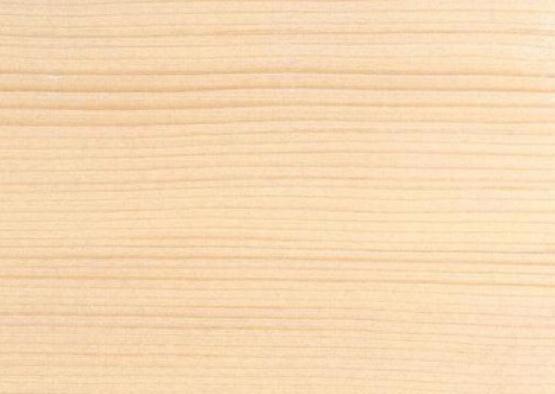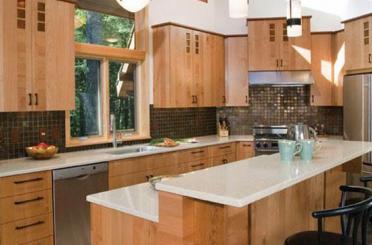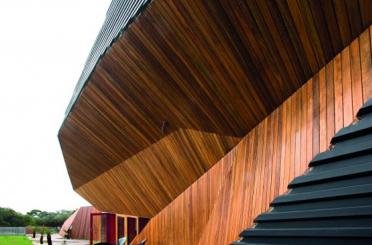Norway spruce is an economically important coniferous species grown in Europe and North America. It is used widely in general construction. Superior grades are prized as a premium tonewood.
Nordic Whitewood, Baltic White Wood, White Deal, European Spruce, Rumanian Whitewood, White Fir, White Spruce, Violin Wood, Picea excelsa, Carpathian Spruce
Picea abies, syn. P. excelsa

Norway spruce is one of the most economically important coniferous species in Europe, where it is forested for paper production, and for its timber, known as deal or whitewood.
The timber of this species is flexible and durable. Its relative lightness, long length and straightness make it ideal for wooden ladders, oars, roofing timbers and paper pulp. Construction grades are commonly used for non-structural applications such as flooring and cladding, inexpensive furniture, joinery and general carpentry. Top-grade Norway spruce is a premium tonewood prized by luthiers for its acoustic properties; it is a timber of choice for acoustic guitar soundboards.
The sapwood of Norway spruce is white to pale yellow in colour, its heartwood is not always distinguishable but often tinged with brown and reddish-brown hues. Growth rings are prominently marked by the darker, denser summerwood. The grain of Norway spruce is relatively fine, and typically straight. Knots are clustered together rather than randomly distributed. Timber surfaces often exhibit a slight lustre.
Norway spruce is easy to work, except for the small tight knots that quickly dull tool edges. It glues satisfactorily using standard bonding procedures. Norway spruce can give poor results when being stained, due to its closed-pore structure. A sanding sealer, gel stain or toner is recommended when colouring Norway spruce timber.
Norway spruce is resinous, and its sawdust is reported to cause skin irritation and respiratory problems among some users.
Shrinkage
| Very Low | Low | Medium | High | Very High | |
|---|---|---|---|---|---|

|

|
||||
Tangential : |
5.00%
|
||||
Radial : |
1.90%
|
||||
Unit Movement Tangential: |
0.33%
|
||||
Unit Movement Radial: |
0.16%
|
Strength Group

Very High |
High |
Reasonably High |
Medium High |
Medium |
Reasonably Low |
Low |
Very Low |
||
Unseasoned: |
S1 |
S2 |
S3 |
S4 |
S5 |
S6 |
S7 |
S8 |
|
|---|---|---|---|---|---|---|---|---|---|
 |
|||||||||
Seasoned: |
SD1 |
SD2 |
SD3 |
SD4 |
SD5 |
SD6 |
SD7 |
SD8 |
|
 |
Stress Grade

| Structural No. 1 |
Structural No. 2 |
Structural No. 3 |
Structural No. 4 |
Structural No. 5 |
|
Unseasoned: |
F8 |
F7 |
F5 |
F4 |
|
Seasoned: |
F17 |
F14 |
F11 |
F8 |
F7 |
Density per Standard

Seasoned: |
470kg/m3
|
|---|---|
Unseasoned: |
580kg/m3
|
Joint Group

Very High |
High |
Reasonably High |
Medium |
Low |
Very Low |
|
Unseasoned: |
J1 |
J2 |
J3 |
J4 |
J5 |
J6 |
|---|---|---|---|---|---|---|
Seasoned: |
JD1 |
JD2 |
JD3 |
JD4 |
JD5 |
JD6 |
Colour

| White, yellow, pale straw to light brown | Pink to pink brown | Light to dark red | Brown, chocolate, mottled or streaky | |
 |
||||
Mechanical Properties
Modulus of Rupture - Unseasoned: |
35
|
|---|---|
Modulus of Rupture - Seasoned: |
66
|
Modulus of Elasticity - Unseasoned: |
7.3
|
Modulus of Elasticity - Seasoned: |
8.2
|
Maximum Crushing Strength - Unseasoned:  |
17
|
Maximum Crushing Strength - Seasoned: |
41
|
Impact - Unseasoned: |
|
Impact - Seasoned: |
|
Toughness - Unseasoned: |
Low - up to 15 Nm
|
Toughness - Seasoned: |
Low - up to 15 Nm
|
Hardness - Unseasoned: |
<1.8
|
Hardness - Seasoned: |
2
|
Durability
| Low | Moderate | Reasonably High | High | |
| (0 - 5 yrs) | (5 - 15 yrs) | (15 - 25 yrs) | (more than 25 yrs) | |
In-Ground: |
 |
|||
| (0 - 7 yrs) | (7 - 15 yrs) | (15 - 40 yrs) | (More than 40 yrs) | |
Above ground: |
||||
| (0 - 20 yrs, usually < 5) | (21 - 40 yrs) | (41 - 64 yrs) | (More than 60 yrs) | |
Marine Borer Resistance: |
 |
Lyctid Borer Susceptibility: |
Not Susceptible |
|---|---|
Lyctid Borer Susceptibility - Other: |
|
Termite Resistance: |
Fire Properties
| 1 - non-combustible | 2 - reasonably non-combustible | 3 - slightly combustible | 4 - combustible | |
Fire Properties Group |
Average Specific Extinction Area: |
<250
|
|---|---|
Bushfire Resistance: |
Not Tested
|
The sapwood of this species is white to pale yellow in colour; the heartwood is brown to reddish brown. Growth rings are prominently marked by the darker, denser summerwood. The texture of Norway spruce is relatively fine, and its grain typically straight.
The timber of this species is flexible and durable. Its relative lightness, long length and straightness make it ideal for telegraph poles, wooden ladders, oars, roofing timbers and paper pulp. Construction grades are commonly used for non-structural applications such as flooring and cladding, inexpensive furniture, joinery and general carpentry. Top-grade Norway spruce is a premium tonewood prized by luthiers for its acoustic properties; it is a timber of choice for acoustic guitar soundboards.
Norway spruce is easy to work, except for the small tight knots that quickly dull tool edges. The timber glues satisfactorily using standard bonding procedures. However, it can give poor results when being stained due to its closed-pore structure. A sanding sealer, gel stain or toner is recommended when colouring Norway spruce. It is a resinous timber, and its sawdust is reported to cause skin irritation and respiratory problems among some users.

Joinery

Cladding, External
Framing

Flooring
Allied Forest Products
Australian Timber

Fewings Joinery Pty Ltd

HESS TIMBER GmbH
L.A. COST SRL

Market Timbers
McCormacks Australia

Meyer Timber Pty. Ltd.

Oxley Trade Pty Ltd

Ridgewood Timber Pty Ltd

Stora Enso Australia

Timber Blitz Pty Ltd


